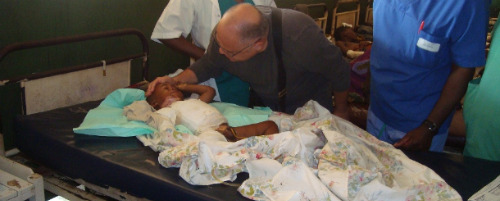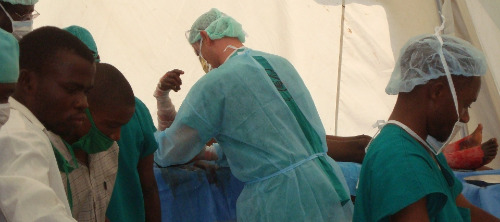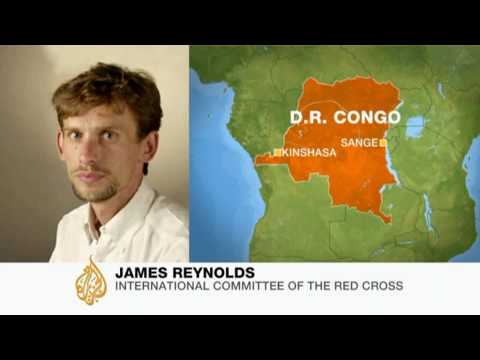Once again, Israel is first on the post-disaster scene, as its specialists in burn treatment and plastic surgery rush to the aid of the Congolese following the recent tragic fire.

“Body beside body, beside body,” is how one reporter described the scene after a devastating fire engulfed a neighborhood in a Congo town two weeks ago. An oil tanker overturned, igniting a nearby cinema packed with people watching the World Cup in Sange, a town of 50,000 about 40 miles from the regional capital city Bukavu. Within 48 hours, an Israeli team was in place to provide expert care to the victims.
Following the disastrous fire, which left about 235 people dead and hundreds with severe burns, locals from Sange were so shocked that they didn’t even cry, according to one account.
With very few burn facilities available to Congolese burned in conflict or domestic situations, the eastern Democratic Republic of the Congo, previously Zaire, relies on foreign aid workers to fill in the gaps. Upon learning about the fire, United Nations workers in Sange quickly called on Gila Garawy, a US-born Israeli woman living in Congo, who works with Israel’s Foreign Ministry.
They knew about her work dedicated to helping doctors in the nearby Congo learn how to treat burns. For the past few years she’s been busy setting up burn treatment programs and facilities via the NGO Moriah Africa that she founded in 2002 following her husband’s death in a plane crash. The two had worked in the Congo as consultants.
Gila hastened to contact Israel’s Foreign Ministry for help. She also informed her associate, Ambassador Haim Divon, who heads MASHAV, the Agency for International Development Cooperation; he is also the deputy director general of the ministry. Divon immediately galvanized Israeli resources to aid the victims.

Israeli team first on scene
Divon tells ISRAEL21c that an Israeli team of doctors and nurses specializing in burn treatment was the first on the scene. “We have been supporting for quite some time Gila’s fantastic work in the Congo in this field, where she is establishing a center to be able to cope with people suffering from burns, as a result of the violent conflict and domestic burns,” he says.
Within 48 hours, he reports, five Israeli doctors and nurses were flown to the Congo where they were joined by a sixth team member – Gila.
In the Congo, there are very few facilities for handling burns, says Divon who helps coordinate Israeli foreign aid around the world, most recently a shipment of blankets and tents to Moldova’s flood victims.
“For many years Gila told me what she was doing and I told her that we’d be very happy to support her,” says Divon, adding that in the recent past MASHAV has supported Israeli doctors on a mission to Congo, and the training of Congo physicians in Israel – where they learned about advanced treatments and methodologies in burn-related plastic surgery.
Headed by Dr. Eyal Winkler from Tel Aviv’s Sheba Medical Center, the team of Israelis should be returning from Congo in about a week. When it returns, its members will submit their evaluation and MASHAV will decide on its next steps. “We want to be able to give our utmost in such a tragic situation,” says Divon. “We were the first team to arrive at the scene and had the blessing of the highest authorities.”
Last Monday, a local newspaper in Israel reported that Congolese President Joseph Kabila had telephoned the Israeli delegation in the Congo to thank them for their help. However, much more still needs to be done.
First-hand accounts from the scene
“We’re carrying half a ton of equipment to treat 30 injured in two locales,” says Winkler, deputy director of Sheba’s department of plastic and reconstructive surgery, speaking from Congo. Along with him are Drs. Shmuel Kalazkin, Ariel Tessone and Gil Gragov Nardini, and nurse Noa Anastasia Ouchakova.
Garaway reports from the scene that not all the burn patients are receiving anesthetics, and that the rural hospitals lack electricity and running water. The pain was so severe that some victims had become psychotic, she says.
In an e-mail update to ISRAEL21c she writes: “We are in Uvira, a town about 30 minutes from where the accident occurred. The team is in its third day of operations. Yes, they are making an impact.
“IsraAid [an Israeli relief organization] is currently trying to find donors to help so that we can leave the dermatome here when the team leaves here on Monday. It is a very expensive piece of equipment which was very kindly loaned by Sheba Medical Center Tel Hashomer [in Israel] along with the team. It must be returned to Israel unless we can find a new replacement that will be on site in Tel Aviv before these guys leave.
“The situation here on the ground: There is no electricity at the moment nor is there running water. There is miraculously an Internet connection as long as my computer battery lasts. Electricity comes and goes here in the town. It’s hard to describe the Congo as a whole if you haven’t been here. Uvira is at the low end of things – a broken patch of pavement running through the town, but that’s it for roads. Minimal economy; and stability is fragile to say the least.
“The Congolese people have tremendous internal strength and reserve to put up with living in the conditions here. This is very evident in the incredible level of pain people are enduring with almost no complaints.
“Bloody, hot, sweaty but working well”
“One of the ward buildings has been turned into a burn-wing with the 30 patients still alive. Between that building and the surgical theater building (old and poorly equipped) there is a special treatment tent where the daily debridements and dressing changes are taking place. It is bloody, hot, sweaty but working well. The team is wearing plastic bags over their shoes to protect [their shoes] from the fluids…
“There are a number of excellent [Congolese] doctors from Kinshasa that were sent here to the ‘scene’ by the government just after the accident. They are working very well with the team. The Israelis have been vey impressed by their sheer grit and willingness to dig in. That interface alone has been wonderful to see,” Gila reports
“There are another 17 burn victims in a small hospital north of here. Although the team has not been able to go up there (too much to do here) the Israeli Ambassador to the Congo went up there the first day together with a journalist, the vice governor and the Congolese Ambassador to Burundi who has accompanied us back and forth across the border each day since the team arrived,” she continues.
“The team would like to assist those as well but it’s not looking possible in their time frame and given the amount there still is to do here. This is another important reason for wanting to leave the dermatome behind – so that the Sange patients can also be treated.”
In the meantime, thanks to a US-Israel initiative, the Congo is to have its first burn center in Bukavu, a city of 250,000. Currently being developed, the three partners in the project comprise MASHAV, Moriah Africa and the Los Angeles human rights organization, Jewish World Watch.
Donations for much-needed equipment can be channeled through Shachar Zahavi of IsraAid.













